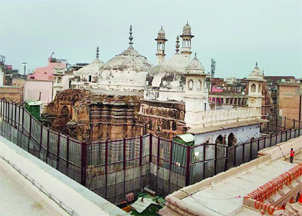
Varanasi (TIP)- In a significant development, Archaeological Survey of India (ASI) in its scientific survey report on the Gyanvapi mosque has concluded that there existed a Hindu temple at the site of the Gyanvapi mosque prior to the construction of the mosque. As per the report, the pre-existing structure was destroyed in the 17th century during the reign of Mughal emperor Aurangzeb.
“The pre-existing structure appears to have been destroyed in the 17th century, during the reign of Aurangzeb, and part of it was modified and reused in the existing structure. Based on scientific studies/ survey carried out, study of architectural remains, exposed features and artefacts, inscriptions, art and sculptures, it can be said that there existed a Hindu temple prior to the construction of the existing structure,” the report, a copy of which is with Bar & Bench, said. Further, sculptures of Hindu deities and carved architectural members were found buried underneath, the report stated.
The survey was done and the report was prepared after the Varanasi district court ordered the same while hearing suits filed by Hindu parties claiming that a temple existed at the spot prior to the mosque.
In July last year, the court had ordered the Director of the ASI to conduct a scientific survey of the Gyanvapi mosque premises, excluding the area previously sealed by the Supreme Court (wuzukhana or an ablution pond). Pursuant to the same, the ASI had carried out the survey. The other relevant excerpts from the ASI report are:
Pillars and Pilasters
A total of 34 inscriptions were recorded during the present survey and 32 Estampages were taken. These are, in fact, inscriptions on the stones of the pre-existing Hindu temples, which have been re-used during the construction/ repair of the existing structure. They include inscriptions in Devanagari, Grantha, Telugu and Kannada scripts. Reuse of earlier inscriptions in the structure, suggest that the earlier structures were destroyed and their parts were reused in construction/repair of the existing structure. Three names of deities such as Janardhana, Rudra, and Umesvara are found in these inscriptions.
Order to demolish the temple
During the recent survey, a stone with inscription was recovered from a room in the mosque. However, the lines relating to construction of the mosque and its expansion have been scratched out. This is also brought out by the biography of Emperor Aurangzeb, Maasir-i-Alamgiri, which mentions that Aurangzeb “issued orders to the governors of all the provinces to demolish the schools and temples of the infidels” (Jadu-Nath Sarkar).
Hindu deities sculptures found buried
Sculptures of Hindu deities and carved architectural members were found buried under the dumped soil in a cellar. Existing architectural remains, decorated mouldings on the walls,kama-ratha and prati-ratha of central chamber, a large decorated entrance gate with torana on the eastern wall of the western chamber, a small entrance with mutilated image on lalat bimba, birds and animals carved for decoration in and outside suggest that the western wall is remaining part of a Hindu temple.





Be the first to comment